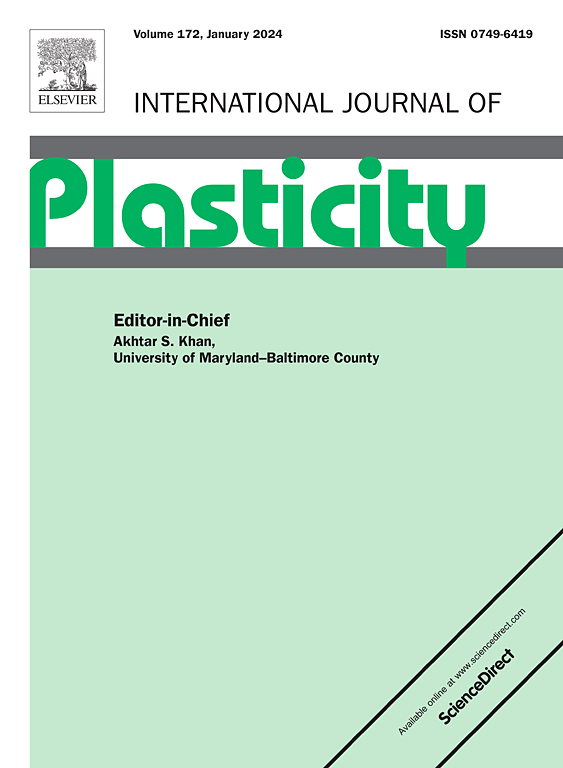通过半相干纳米层状结构,实现NiCoVTa中熵合金在宽温度范围内优异的力学性能
IF 12.8
1区 材料科学
Q1 ENGINEERING, MECHANICAL
引用次数: 0
摘要
本研究引入了一种扩散速率自适应策略,用于设计半相干κ相纳米片增强的高性能NiCoV0.9Ta0.1中熵合金(MEA),在宽温度范围(77-923 K)内实现卓越的强度-塑性协同。在综合计算材料工程(ICME)方法的指导下,结合相图计算(CALPHAD)和密度泛函理论(DFT),筛选了Ta的缓慢扩散,有效地限制了κ-板条增厚,导致纳米级半相干片层结构的形成。超高强度源于纳米层状结构的大量强化作用,以及晶粒尺寸强化和基体抵抗应力的协同作用。此外,高温变形过程中相干纳米级L12析出物的形成弥补了923 K时观察到的强度损失。这种显著的应变硬化行为源于κ条与位错之间的相互作用,即κ条上初始的位错堆积提高了硬化速率,而κ条上随后的位错剪切和层错(SFs)激活则缓解了应力集中,协同稳定了塑性变形。此外,变形引起的位错亚结构,包括9R相、纳米孪晶和位错缠结,有助于在77 K和723 K之间进行高水平的应变硬化。在923 K时,L12析出相与基体中的位错相互作用产生致密的SFs,促进了lmer - cottrell锁的形成和剪切κ条,导致异常硬化。这项工作为先进的M/HEAs建立了一种扩散速率介导的半相干纳米层状结构设计范例,在极端温度应用中具有重要的前景。本文章由计算机程序翻译,如有差异,请以英文原文为准。
Achieving superior mechanical properties over a wide temperature range in NiCoVTa medium-entropy alloy via semi-coherent nanolamellar structure
This study introduces a diffusion-rate-adaptive strategy for designing a high-performance NiCoV0.9Ta0.1 medium-entropy alloy (MEA) strengthened by semi-coherent κ-phase nanolamellae, achieving exceptional strength-ductility synergy across a wide temperature range (77–923 K). Guided by an Integrated Computational Materials Engineering (ICME) approach that combines Calculation of Phase Diagram (CALPHAD) and Density Functional Theory (DFT), Ta addition is screened for sluggish diffusion to effectively restricts κ-lath thickening, leading to the formation of a nanoscale semi-coherent lamellar structure. The resulting ultrahigh strength originates from the substantial strengthening effect of the nanolamellar structure, coupled with synergistic contributions from grain size strengthening and resistance stress from the matrix. Furthermore, the formation of coherent nanoscale L12 precipitates during elevated temperature deformation compensates for the strength loss observed at 923 K. The remarkable strain hardening behavior arises from the interaction between κ laths and dislocations, i.e., initial dislocation pile-ups at the κ laths enhancing the hardening rates, while subsequent dislocation shearing and stacking faults (SFs) activation in the κ laths relieving stress concentrations, synergistically stabilizing plastic deformation. Additionally, deformation-induced dislocation substructures, including 9R phases, nanotwins, and dislocation tangles, contribute to the high level of strain hardening between 77 K and 723 K. At 923 K, dense SFs, generated through the interaction of L12 precipitates with dislocations in the matrix, facilitate Lomer-Cottrell locks formation and shear κ laths, resulting in anomalous hardening. This work establishes a diffusion-rate-mediated semi-coherent nanolamellar structure design paradigm for advanced M/HEAs, with significant promise for extreme‑temperature applications.
求助全文
通过发布文献求助,成功后即可免费获取论文全文。
去求助
来源期刊

International Journal of Plasticity
工程技术-材料科学:综合
CiteScore
15.30
自引率
26.50%
发文量
256
审稿时长
46 days
期刊介绍:
International Journal of Plasticity aims to present original research encompassing all facets of plastic deformation, damage, and fracture behavior in both isotropic and anisotropic solids. This includes exploring the thermodynamics of plasticity and fracture, continuum theory, and macroscopic as well as microscopic phenomena.
Topics of interest span the plastic behavior of single crystals and polycrystalline metals, ceramics, rocks, soils, composites, nanocrystalline and microelectronics materials, shape memory alloys, ferroelectric ceramics, thin films, and polymers. Additionally, the journal covers plasticity aspects of failure and fracture mechanics. Contributions involving significant experimental, numerical, or theoretical advancements that enhance the understanding of the plastic behavior of solids are particularly valued. Papers addressing the modeling of finite nonlinear elastic deformation, bearing similarities to the modeling of plastic deformation, are also welcomed.
 求助内容:
求助内容: 应助结果提醒方式:
应助结果提醒方式:


